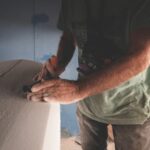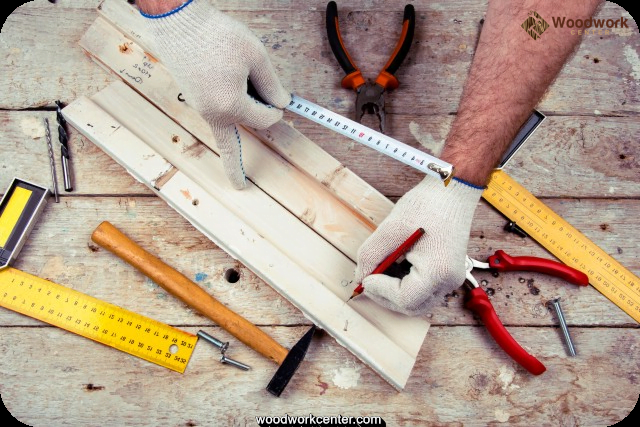Woodworking has gained increasing popularity in recent years as people rediscover the joy of working with their hands and creating something beautiful from wood. However, amidst the excitement and creativity, it is essential to prioritize safety above all else. In any woodworking project, safety should be the top priority, and one crucial aspect of safety is wearing protective eyewear such as safety glasses.
Woodworking can involve various hazards and risks that can lead to serious injuries if proper precautions are not taken. Without adequate eye protection, there is a significant danger of wood chips, sawdust, or flying debris entering the eyes and causing damage.
The eyes are incredibly delicate organs, and any injury to them can have long-term consequences. It is vital to understand why safety glasses are essential in the woodwork room and how they play a crucial role in preventing eye injuries.
Statistics show that eye injuries related to woodworking accidents are alarmingly common. According to the American Academy of Ophthalmology, over 20,000 eye injuries occur annually due to woodworking accidents in the United States alone. These injuries range from minor irritations caused by dust particles to severe trauma resulting in permanent vision loss. Understanding the types of injuries that can occur and their potential long-term effects underscores the importance of wearing safety glasses.
Safety glasses act as a barrier against potential eye injuries by providing a physical shield that prevents objects from directly contacting the eyes. They are designed with impact-resistant materials and often feature wrap-around designs to offer maximum coverage and protection. Some safety glasses also come with anti-fog coatings or tinted lenses to enhance visibility in different lighting conditions. By wearing safety glasses in the woodwork room, individuals significantly reduce their risk of sustaining eye injuries.
The Dangers of Woodworking Without Safety Glasses
Woodworking can be an enjoyable and fulfilling activity, allowing individuals to create beautiful and functional pieces. However, it is important to always prioritize safety in the woodwork room. One of the key safety measures that should never be overlooked is wearing safety glasses. Without them, woodworkers are exposing their eyes to a range of potential hazards and risks.
Woodworking involves various processes that can generate flying debris, such as sawing, sanding, drilling, and shaping. These particles may include small fragments of wood, metal shavings, dust, or even objects propelled by power tools. When these airborne materials come into contact with the eyes, they can cause serious damage and injury.
The eyes are highly sensitive organs that are vulnerable to injuries from impacts, penetration, or chemicals. According to a study conducted by the American Academy of Ophthalmology (AAO), woodworking accidents account for a significant number of eye injuries each year. In fact, woodworking ranks among the top activities associated with eye injuries in both professional and hobbyist contexts.
Facts about Woodworking-Related Eye Injuries
| Statistics | Data |
|---|---|
| Annual number of eye injuries related to woodworking accidents in the United States | Approximately 22,000 cases |
| Percentage of woodworking-related eye injuries caused by flying debris | Over 70% |
| Types of woodworking-related eye injuries | Lacerations/abrasions (40%), foreign bodies (30%), blunt trauma (20%), chemical burns (10%) |
| Average time lost from work due to eye injuries | 5 days |
| Estimated annual cost of eye injuries in the woodworking industry | $200 million |
These statistics highlight the significance of protecting the eyes while woodworking. Eye injuries can lead to severe consequences, including vision loss, permanent damage, and even blindness. To prevent such incidents, it is crucial for woodworkers to wear safety glasses that meet appropriate standards for impact resistance.
Safety glasses provide a strong barrier between the eyes and potential hazards. They feature impact-resistant lenses that can withstand high-speed projectiles without shattering. Additionally, these glasses often have side shields or wrap-around designs that offer additional protection from flying debris entering from the sides.
Overall, understanding the dangers of woodworking without safety glasses is pivotal in promoting a culture of safety in any woodwork room. By wearing proper eye protection, woodworkers can significantly reduce the risk of sustaining eye injuries and ensure their long-term ocular health.
Understanding Eye Injuries in the Woodwork Room
Woodworking is a popular and rewarding hobby that allows individuals to create beautiful and functional pieces from wood. However, it is important to recognize that woodworking can also pose serious dangers if proper safety precautions are not taken. One area of great concern is the potential for eye injuries in the woodwork room. This section aims to shed light on the statistics, types of injuries, and long-term effects associated with woodworking accidents specifically related to the eyes.
Statistics show that woodworking accidents can lead to a significant number of eye injuries. According to the Centers for Disease Control and Prevention (CDC), approximately 2,000 workers annually sustain eye injuries while working with wood or wood products. These injuries range from minor scratches and abrasions to more severe traumas such as punctures, cuts, or foreign objects embedded in the eye.
Eye injuries in the woodwork room can result from various causes. One common cause is flying debris such as sawdust, wood chips, or splinters that may be projected into the air during cutting, sanding, or shaping processes. Additionally, tools like chisels or drills can generate sparks or fragments that have the potential to enter the eye. The eyes are extremely sensitive and vulnerable organs that can easily be damaged if exposed to these hazards.
The long-term effects of eye injuries sustained in woodworking accidents can be devastating. Permanent vision loss, partial vision impairment, or reduced depth perception are just a few examples of potential consequences that can greatly impact an individual’s quality of life.
Furthermore, even minor injuries like corneal abrasions or infections may require medical attention and prolonged recovery periods. It is essential for individuals engaging in woodworking activities to understand these risks and take necessary precautions to protect their eyes from harm.
How Safety Glasses Protect You in the Woodwork Room
Safety glasses play a crucial role in protecting your eyes while working in the woodwork room. Woodworking involves various hazards that can pose serious risks to your eyesight. Without proper eye protection, you are exposed to potential injuries from flying wood chips, debris, dust particles, and even accidental contact with sharp tools and equipment. In this section, we will delve into how safety glasses act as a barrier against these dangers and why they are essential for every woodworking project.
Safety glasses provide a physical barrier between your eyes and the potential hazards present in the woodwork room. They are specifically designed to withstand impact from high-velocity objects, protecting your eyes from injuries caused by flying debris or projectiles. The lenses of safety glasses are made from impact-resistant materials such as polycarbonate or Trivex, which are much stronger than regular glass or plastic lenses.
In addition to impact resistance, safety glasses also offer protection against other dangers in the woodwork room. They have side shields or wraparound frames to prevent objects from entering from the sides and causing injury. Some safety glasses also feature anti-fog coatings or ventilation systems to ensure clear vision even in humid environments.
It is important to choose safety glasses with appropriate lens tints that enhance visibility without compromising protection. For example, clear lenses provide optimal visibility indoors under normal lighting conditions, while tinted lenses are suitable for outdoor woodworking projects where bright sunlight may cause glare.
To illustrate the effectiveness of safety glasses, consider the following statistics: according to a study conducted by the U.S Bureau of Labor Statistics (BLS), over 1 million eye injuries occur each year due to workplace accidents, many of which involve woodworking activities. Furthermore, data from the American Academy of Ophthalmology (AAO) suggests that nearly 90% of these injuries could have been prevented if individuals had been wearing proper eye protection such as safety glasses.
By providing an effective barrier against potential dangers, safety goggles significantly reduce the risk of eye injuries in the woodwork room. They are an essential piece of personal protective equipment (PPE) that every woodworker should wear to ensure their safety and preserve their eyesight. Remember, it only takes a split second for an accident to occur, but wearing safety glasses can make a lifetime difference in protecting your vision.
Choosing the Right Safety Glasses for Woodworking
When it comes to woodworking, safety should always be a top priority. One essential aspect of ensuring your safety in the woodwork room is choosing the right safety glasses. With the potential hazards and risks involved in woodworking projects, selecting appropriate eye protection is crucial for preventing serious eye injuries.
The first factor to consider when choosing safety glasses for woodworking is impact resistance. Woodworking involves various activities that can cause flying debris, such as sawing, sanding, and drilling. Safety glasses with high impact resistance can effectively protect your eyes from these potential projectiles. Look for glasses that comply with ANSI Z87.1 standards, which provide assurance of their level of impact resistance.
Another consideration is tint. Depending on the lighting conditions in your woodwork room, you may need safety glasses with tinted lenses to reduce glare and enhance visibility. However, be mindful that excessive darkness can hinder your ability to see fine details or evaluate color variations accurately. Opt for a tint that strikes a balance between comfort and clarity.
Comfort is also essential when selecting safety glasses for woodworking projects. Since you may wear them for an extended period, look for glasses with adjustable frames and nose pads to ensure a proper fit and reduce fatigue during use. Additionally, consider styles that offer anti-fog coatings or ventilation channels to prevent fogging caused by perspiration or temperature changes.
Remember to prioritize eye protection over fashion or aesthetics when choosing safety glasses for woodworking tasks. While there are different designs available in the market, focus on finding eyewear that meets the necessary safety requirements rather than solely depending on appearance.
By carefully considering factors such as impact resistance, tint, comfort, and compliance with industry standards, you can choose the right safety glasses suitable for your woodworking needs. Proper eye protection remains crucial in avoiding potentially life-altering eye injuries while enjoying the craft of woodworking.
Proper Usage and Maintenance of Safety Glasses
When working in the woodwork room, wearing safety glasses is essential to protect your eyes from potential hazards. However, simply putting on a pair of safety glasses is not enough – it is crucial to know how to properly use and maintain them as well. This section will provide step-by-step instructions on correctly wearing safety glasses and offer tips for ensuring their maximum protection and longevity.
Firstly, always make sure to choose safety glasses that fit properly and comfortably on your face. Ill-fitting glasses can be a distraction and may fail to provide adequate protection. Adjust the temples or nose pads if necessary to achieve a secure fit.
Once you have the right fit, ensure that the safety glasses are clean before each use. Dust, debris, or smudges on the lenses can obstruct your vision, increasing the risk of accidents. Using a lens cleaner or mild soap and water, gently wipe both sides of the lenses with a soft cloth or lens cleaning tissue. Avoid using abrasive materials that may scratch or damage the lenses.
Additionally, it is important to wear safety glasses continuously during woodworking tasks, even if they seem unnecessary at times. Flying wood chips or sawdust can easily enter your eyes and cause harm. Keep in mind that accidents can occur in an instant, so maintaining consistent eye protection is crucial.
Furthermore, do not forget about proper storage when you are not using your safety glasses. Always keep them protected in a case or pouch when not in use to prevent scratches or accidental damage. Additionally, store them away from direct sunlight or extreme temperatures as these conditions could affect their durability.
By following these guidelines for proper usage and maintenance of safety glasses, you can ensure their effectiveness in protecting your eyes during woodworking projects. Remember that investing time and effort into wearing and caring for your safety equipment will contribute greatly to creating a safe woodworking environment for yourself and others around you.
Additional Safety Measures in the Woodwork Room
When it comes to ensuring safety in the woodwork room, wearing safety glasses is just one piece of the puzzle. There are several other important safety measures that should be followed to minimize the risk of accidents and injuries. By implementing these additional measures, woodworkers can create a safer and more productive environment.
- Use dust masks: Woodworking involves various activities that generate a significant amount of dust and particles, which can pose health risks if inhaled. It is essential to wear a properly fitted dust mask or respirator to protect your respiratory system from small particles that may carry contaminants or irritants.
- Wear ear protection: Exposure to loud noises in the woodwork room can cause permanent hearing damage over time. Therefore, it is crucial to wear ear protection such as earplugs or earmuffs when operating noisy machinery or power tools. This will help safeguard your hearing and prevent potential long-term hearing loss.
- Dress appropriately: Loose clothing, jewelry, and long hair can get caught in machinery or tools, leading to severe injuries. Always wear clothing made of non-flammable material that fits snugly without restricting movement. Remove any accessories that could become entangled and tie back long hair.
- Maintain a clean workspace: A cluttered work area increases the likelihood of accidents and injuries. Keep your workspace organized by properly storing tools and materials when not in use. This will reduce tripping hazards and make it easier to focus on your work without distractions.
Following these additional safety measures along with wearing safety glasses will provide comprehensive protection for woodworkers in the woodwork room environment. By prioritizing safety at all times, you can enjoy woodworking while minimizing the risk of accidents and maintaining a safe work environment for yourself and others around you.
Real-Life Examples
Woodworking accidents can have devastating consequences, especially when it comes to eye injuries. Without proper eye protection, even a minor mishap in the woodwork room can result in long-lasting damage. Sharing real-life examples of individuals who have suffered eye injuries serves as a powerful reminder of why safety glasses are crucial in any woodworking project.
Case Study 1: John’s Near-Blinding Accident
One such example is John, an experienced woodworker who was working on a lathe without wearing safety glasses. As he was turning a piece of wood, a stray chip flew into his right eye at high speed. The sharp edge of the chip caused a deep corneal laceration and significant damage to John’s vision. He underwent multiple surgeries but unfortunately lost most of his sight in that eye.
Case Study 2: Sarah’s Splinter Mishap
In another unfortunate incident, Sarah was handling pieces of reclaimed wood without wearing safety glasses. As she was gripping one particularly rough-edged piece, a splinter broke off and flew directly into her left eye with force. The splinter caused severe pain and irritation, leading to an infection that required extensive medical treatment. Although Sarah did not suffer permanent loss of vision, she was unable to work for several weeks due to the injury.
These real-life examples serve as cautionary tales for all those involved in woodworking projects. Eye injuries can happen in an instant and have life-changing consequences that could easily be prevented by wearing appropriate safety glasses. These stories underscore the importance of prioritizing eye safety while working in the woodwork room and highlight why safety glasses are not just optional but essential equipment for every woodworker.
By sharing these experiences, we hope to raise awareness among both beginners and experienced woodworkers about the hazards they face and encourage them to take proactive measures to protect their eyes. Safety glasses should never be considered an inconvenience or an afterthought; they are a vital part of ensuring the well-being and long-term vision health of woodworkers. Remember, one moment of negligence can have permanent repercussions, but a commitment to safety can help prevent avoidable accidents and injuries.
Conclusion
In conclusion, the importance of safety glasses in the woodwork room cannot be overstated. Woodworking has gained popularity as a creative and fulfilling hobby, but it also poses significant risks and hazards. The eyes are particularly vulnerable to injury in this environment, making safety glasses an essential piece of protective gear.
Throughout this article, we have explored the dangers of woodworking without safety glasses and the potential eye injuries that can occur. We have seen how even a momentary lapse in precaution can lead to life-changing consequences. However, safety glasses provide a crucial barrier against these risks.
Different types of safety glasses offer various features that enhance their effectiveness. Impact resistance is one such feature to consider when choosing the right pair for woodworking projects. Additionally, factors like tint and comfort play a role in ensuring maximum protection and ease of use.
Proper usage and maintenance are key to maintaining the longevity and effectiveness of safety glasses. By following step-by-step instructions on wearing them correctly and taking care of them, you can ensure ongoing protection for your eyes.
It is important to note that safety glasses should not be the only safety measure taken in the woodwork room. Dust masks, ear protection, and appropriate attire are also crucial components in reducing the risk of accidents or injuries.
Real-life examples shared throughout this article have highlighted individuals who suffered avoidable eye injuries due to inadequate eye protection. These stories remind us of the life-changing consequences that could have been prevented with the simple use of safety glasses.
Frequently Asked Questions
Why is it important to wear safety glasses in the workplace?
Safety glasses are extremely important to wear in the workplace because they provide crucial eye protection. In any environment where there is a risk of debris, flying particles, chemicals, or other hazardous materials coming in contact with the eyes, safety glasses act as a barrier and prevent potential injuries.
Even a small particle or splinter can cause significant damage to the eyes, leading to pain, vision impairment, or even permanent blindness. By wearing safety glasses, workers can minimize these risks and ensure their long-term eye health.
What are safety glasses used for in carpentry?
Safety glasses serve a vital purpose in carpentry by shielding the eyes from various hazards encountered in this field. Carpenters work with sharp tools such as saws, hammers, chisels, and drills that can release wood chips, dust, or fragments during cutting or shaping processes. These particles have the potential to fly into the eyes and cause injuries like scratches or abrasions on the cornea.
Additionally, carpentry involves working with chemicals like adhesives or varnishes that may splash into the eyes accidentally. Safety glasses provide necessary protection against these potential dangers and reduce the likelihood of eye-related accidents.
When should safety glasses be worn in wood tech?
Safety glasses should be worn at all times in wood tech classes where students learn woodworking techniques. Wood tech involves using various tools such as chisels, saws, sanders, drills, etc., which generate wood dust and debris when working with different types of wood materials. These fine particles can easily get airborne and enter the eyes if not protected correctly.
Additionally, woodworking activities often include cutting wood pieces using power tools or hand-held tools that create fast motion which propels small fragments towards the worker’s face area. Wearing safety glasses helps safeguard against both obvious and unseen risks associated with these activities in wood tech classes and ensures students’ eye safety while learning practical skills in woodworking.

Hi everyone! I’m a woodworker and blogger, and this is my woodworking blog. In my blog, I share tips and tricks for woodworkers of all skill levels, as well as project ideas that you can try yourself.





